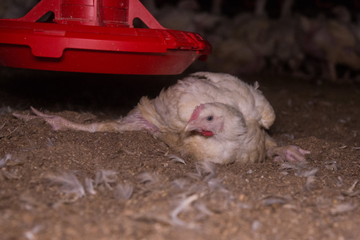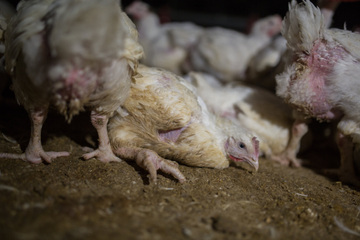Why the Better Chicken Commitment
Consumers are demanding improved animal welfare and food quality standards.

Consumer Demand
Studies show that consumers are increasingly concerned about where their food comes from.
A 2018 study[1] for the Australian government’s Department of Agriculture and Water Resources found that 95% of people view farmed animal welfare to be a concern and 91% want at least some reform to address this.
In New Zealand in 2017, The Ministry for Primary Industries issued a report[2] on New Zealanders’ views of farmed animal welfare. Over 95% of respondents agreed, “It is important that the welfare of farmed animals in New Zealand is protected.”
Animal Welfare
Breed
The modern chicken has been selectively bred and commercialised over many decades, prioritising fast growth and large breast muscles over any consideration for welfare. Chickens now grow so big, so quickly, their bodies can’t keep up. Their legs can’t cope with the weight of their upper bodies so they suffer from leg pain and lameness. Their hearts and other organs are under pressure, and many die prematurely from heart disease. These welfare issues are due to chickens being bred for abnormally fast growth.[3]

Stocking Density
Numerous studies have linked the problems of movement and ammonia burns to stocking density3. When chickens are crammed so tightly together, the litter soon becomes soiled and mobility is decreased because birds have inadequate room to move.[4]

Housing
As standard industry practice, chickens are forced to live in a completely barren environment with litter on the floor of the sheds which becomes increasingly dirty over the birds’ life. As they grow bigger, they have little space to move. Many never see natural light and are subjected to low-intensity artificial lighting.
So many chickens with so little space per bird means that they live right on top of their own waste. This ongoing contact with the ammonia-laden litter can cause foot pad dermatitis (lesions on the bottom of their feet), breast blisters, and hock burns (ammonia burns through the skin).[5] These conditions all result in extremely poor welfare.

Slaughter
The most prevalent slaughter method for chickens produced for the Australia and New Zealand market is live-shackling, a system by which birds are hung upside down by their feet in metal shackles5 (called inversion). An electrified water bath is meant to give them a shock that renders them unconscious; however, many are not effectively stunned and have to be re-stunned.
Live shackling causes pain, fear and stress, which can lead to wing-flapping and struggling. In combination with breeding practices that mean that conventionally reared chickens are prone to metabolic and skeletal defects, inversion is associated with injuries such as dislocations and fractures.
Future Eye. Commodity or sentient being? Australia’s Shifting Mindset on Farm Animal Welfare. (2018) ↩︎
Ministry for Primary Industries. New Zealanders’ views of the primary sector. (2017) ↩︎
Hartcher, K, & Lum, H. Genetic selection of broilers and welfare consequences: a review. World’s Poultry Science Journal 76:1, 154-167 (2020) ↩︎
Ibid. ↩︎
Haslam, S. M. et al. Factors affecting the prevalence of foot pad dermatitis, hock burn and breast burn in broiler chicken. Br. Poult. Sci. 48, 264–275 (2007) ↩︎
